#riga by locals
Explore tagged Tumblr posts
Text
What even is my life... 😂
So I'm at the airport, right.
Waiting for my flight to Riga where I'm going on a 2-day break (followed by Trondheim but that's beside the point) and I'm just chilling at the gate waiting to board when... who do I see... 🧐

Oh yes indeed.
2.0. 😂😂😂
Which of course means... HE IS HERE TOO. ⚠️
So naturally I move closer to the gate and next I spot Nana the camel (🤦🏼♀️🎒🎒🎒🎒) chatting to who I assume was an airport handler or smthg like that.

With a bag full of local natural food snackies. 😉
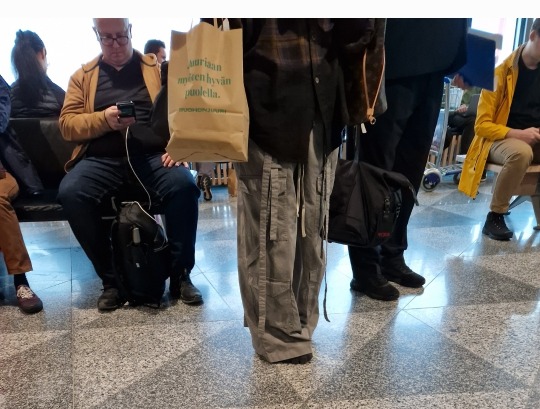
And then out of the blue just minutes before boarding...

...HE waltzes by. 😂👋
A few younger gals also recognized him and there were gasps and all that. 🤭😱
They go right through the gates before anyone else is allowed, of course. 🫅
So then we blebs are invited to board and I KNOW I have to get smthg out of this situation so I'm thinking how do I get footage without it being too obvious?! 🤔
We all remember that one plane pic couple months back where JL was secretly filmed by someone while boarding and he saw it and looked miffed so I def didn't wanna repeat that! 😬
So obvs pics were out of the question, but...
Video. 😏
VIDEO, baby! 😏
I could set my video to record and just shut the lid and no one would know it's on. 🤷🏼♀️
And soooo...
Look, am I proud of myself?
Perhaps not. 🤷🏼♀️
BUT AS IF Y'ALL WOULDN'T HAVE. 🤨🫵😂
Anyhoo THOUGHTS! ⚠️
1. They had the entire business/1st class area booked for themselves, which means they are paying for 15 seats but only using 3. 😂💸💸💸
2. La Principessa needs to have her own private row away from the riff-raff servants who quite happily seemed to enjoy sitting together. 😉
3. SNACKIES NEED THEIR OWN SEAT. 😎
And yes, this is a great time to point out the glaringly obvious:
NO ONE ELSE TRAVELLED WITH THEM.
No SL, no Stevie, not anyone. 👀
Okay I saw a few Mars hoodies and caps on folks so MAYBE they were roadies, but they certainly did not get 1st class seats nor did they socialize with these 3 in any way so I'm more inclined to believe they were just fans going to the Riga show. 🤔
But now back to the flight! ✈️
I was sitting back in row 20 so no way to see the posh folks in their ivory tower, but I did giggle to myself the entire 55 minute flight over the sheer absurdity of the situation... 🤭
Me of all people stuuuuck in a metal box with Lord Messiah 10k up in the air. 😂
Like... there are around 20 flights between Riga and Helsinki by 2 different airlines every day, and we end up on the same one?! 😂🤪
The universe, man... 😂🫣
AND!!! Imagine if smthg went terribly wrong and our plane had crashed!
Imagine me DYING IN A PLANE CRASH WITH JARED GOD DAMN LETO??????? 💀😳
That's some wild shit, man... 😂
Anyway, then we land and as we taxi to our spot I notice a building right by our plane with a fancy black car waiting.

VIP!!!! 🫅
Oooof course. 😎
Then we park and I lose eye contact with the weasel cos everyone jumps up and blocks my view, and I knew for a fact he would be getting off first and quite possibly into a car which will whisk him to that building which was right in my view...
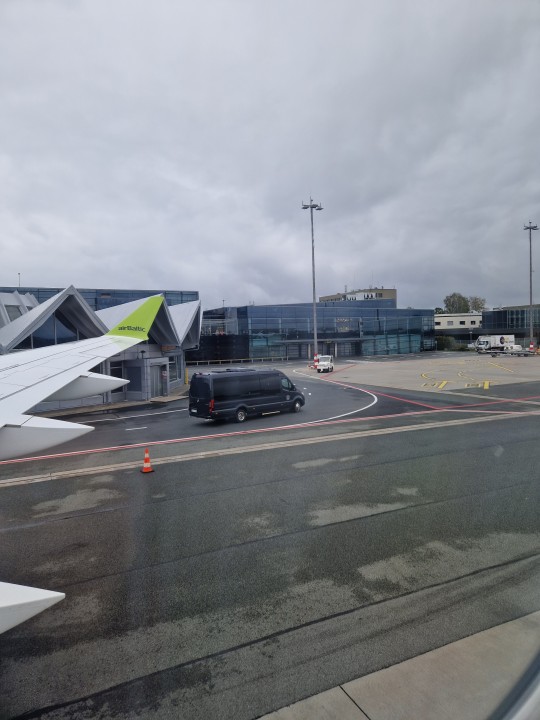
...and viola! 😛
The van swerves to the door and Nana hops out...

...followed by the weasel and 2.0. 😂

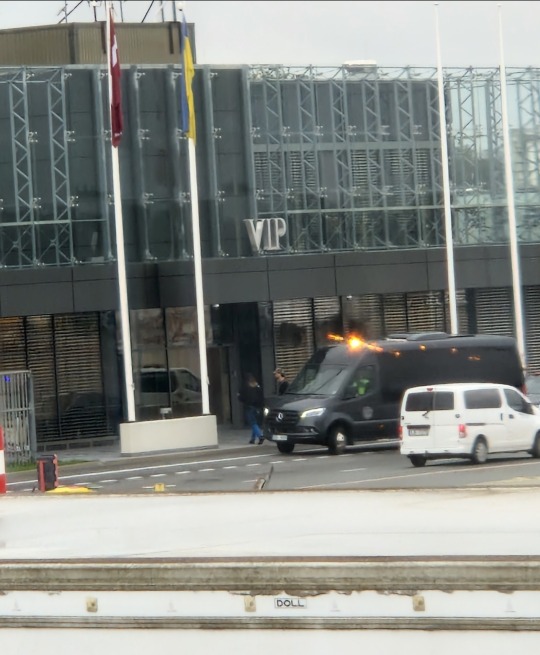
Naturally Messiahs don't do bleb customs! ✌️
His Holiness disappeared into the VIP building and Yours Truly was left to pick up her rags and find transport into town since apparently hitching a ride in that big ol' van was a nope. 🤷🏼♀️
And thus we close another insane chapter of the neverending #Kared4Evah saga! 😂👫
But not before I leave you with what I consider to perhaps be the greatest piece of content I managed to grab during this whole shebang:
BEHOLD!!!! ⚠️

LETO ASS PRINT!!! 😂😂😂😂🍑
And his garbage which they definitely don't ask travellers to take with them when leaving the aircraft. 🙄
But hey.
LA PRINCIPESSA WOULD NEVAH. 👸✌️
30 notes
·
View notes
Text
It's the media, stupid!
No, I'm not talking about specifics of various news media outlets or nitpicking about particular stories or attitudes. The problem is the vast overall state of the media environment in the United States.
Kate Riga is on target with her blog entry at TMP. (emphasis added)
Democrats Just Can’t Compete In This Media Environment
[T]here’s one leading factor that Democrats absolutely need to respond to as quickly as possible to avert this kind of electoral disaster in the future: the media environment unequivocally favors Republicans. We don’t have a ton of data yet, and much of it is partial. But we can already tell that Harris performed best — that is, underperformed least — in the battleground states. In the places where her campaign flooded the airwaves with her messaging, put her on TV shows and radio stations and in local newspapers, scattered driveways with information flyers, positioned her beside local celebrities, she improved on the repudiation of Democrats that infected nearly every other state. In other words: In the states where she set up a temporary but pervasive media apparatus, she negated some of the nationwide drag. That speaks to the reality that most of the country is awash in right-wing propaganda all the time. For the olds, it’s Fox News and conservative radio; for the youths, it’s the right-wing manosphere podcasts and streams that Trump so assiduously courted all campaign long (plus soothing TikToks promoting retrograde gender roles, evangelical values and distrust of government regulation — think the trad wives and crunchy so-far-left-they’ve-looped-around-to-the-right content — aimed specifically at women). It helps explain Biden’s prodigious unpopularity, despite passing a ton of legislation that not only polls well, but has meaningfully improved people’s lives. It helps elucidate the consistent claims that people don’t know what Harris stood for, before and after she released her policy proposals. It’s a playing field that Republicans not only dominate; Democrats don’t even compete. They still depend heavily on traditional media sources that simply don’t operate the same way these right-wing PR arms do. And we know that these forms of media are powerful; they reach tons of people, and are seen as useful enough pawns that Russia has invested in some of them. This isn’t a novel observation. The Obama alums who started Pod Save America and the greater Crooked Media family did so after Trump won in 2016 specifically to try to build up a Fox News of the left. There are structural problems with mimicking this right-wing content beat-for-beat. The Pod Save guys, while open about their political allegiances, often criticize the party and its politicians. It would be much more difficult to recreate the fawning adoration of Donald Trump Fox News and those podcasts produce for, say, Joe Biden on the left. It requires creativity and investment, but I think Democrats and those aligned with them could do it. Voters say over and over that they prefer Democratic policies — even Republicans often vote for them when they’re standalone ballot initiatives. It’ll require a cultivation of talent, a saturation of these spaces, finagling how to wrest back the counter-cultural bad boy persona from those who are espousing a way of life most people consider retrograde, confining, divisive and exhausting, not to mention solely in service of the plutocratic elites that run the party. Obama was such a revelation because he hijacked technology in a way that was new and exciting for people, and it helped him micro-target low propensity voters. Trump has since taken that mantle. In the two and then four years ahead, Democrats have to find a way to get in people’s eyes and ears, to figure out how to make an affirmative case in these spaces that people would likely respond to if they were exposed to it.
It's not just Fox News – which is bad enough by itself. There are the rightwing talk radio stations dating back to the 1980s. They joined Christian fundamentalist stations which had been pushing social conservative positions since the 1930s. And now there are countless bro types who talk rightwing shit for hours at a time on their podcasts.
Apart from Obama's skillful use of social media when it was still new, Democrats have fallen behind with digital media. Most recently, Elon Musk bought Twitter simply to use it as a propaganda machine. Facebook and its sister sites like Instagram use algorithms which promote rightwing talking points.
There had been attempts to set up liberal talk radio. But they have been sporadic and met with mixed success. Al Franken set up a liberal radio network called Air America Radio in 2004. But it had only modest reach on mostly medium powered stations and ultimately filed for bankruptcy during the Great Recession.
We need to increase our news and information footprint in a major way and on multiple media platforms – and fast. Obviously that takes money and business talent. So if you find yourself next to Mark Cuban, Bill Gates, or Michael Bloomberg on a flight or in an elevator, have your pitch ready. If that doesn't happen, we need to start raising money on our own. Nobody said that freedom is free.
#media#media imbalance#kate riga#news and information media#democrats#rightwing dominance in media environment#rightwing talk shows#air america radio#podcasts#election 2024
22 notes
·
View notes
Note
Bojan is already making plans what he'll do with Jere once he's in Slovenia. He already has a list of things he wants to show and for Jere to try and people to meet. Some plans he told Jere about. Some he's keeping a secret.
That's real, how is this real 😭🫂
Yeah, he's had his list for a WHILE.
The first version was tapped on his notes app on the plane on his way home from his first Helsinki trip. It had a few ideas, some favourite restaurants, their rehearsal space, a club.
It grew over the next few months. I was pretty clear early on that Jere wouldn't make it Ljubljana that summer, but Bojan added in ideas every time something local made him think of Jere.
After Nordic Tour, it was just a list of supplies he needed to stock his own apartment with.
On the bus, at night, on their way from Tallinn to Riga, he put "dinner with parents" on the list. Recording studio, too, but that was official business, and his list is just for them.
When actual plans started to take shape the additions were his favourite ski resort and Ljubljana Christmas market.
After Ruisrock, it was "helicopter ride?" but that was crossed out and replaced with "Bled & the bench".
46 notes
·
View notes
Text

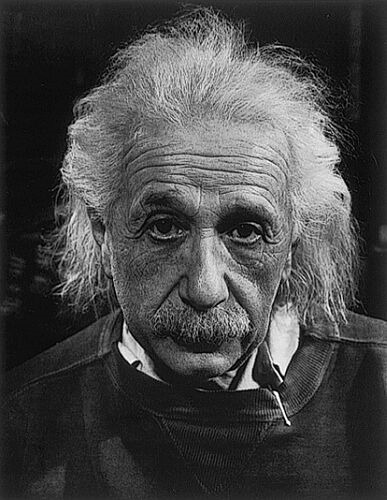

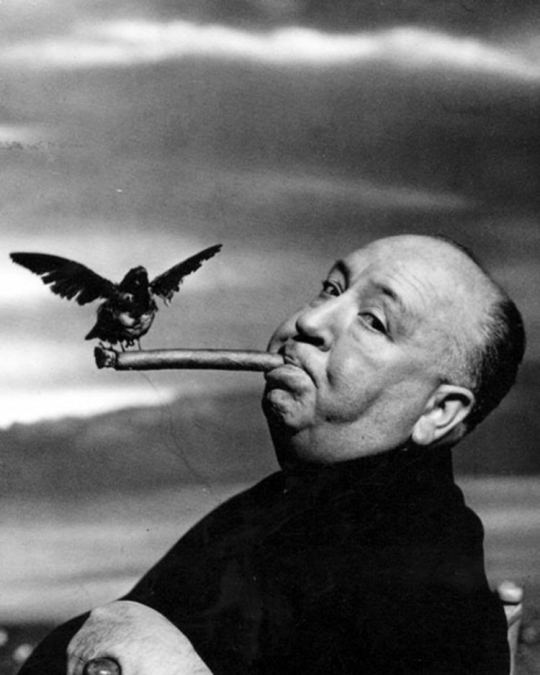
Latvian-born photographer, Philippe Halsman, lived two very different lives. On one hand, he was a celebrated photographer, most known for his work on Dali Atomicus with Salvador Dali. As a young man, however, Philippe was a victim of a horrendous miscarriage of justice.
Born in Riga, Latvia, to Jewish parents - Morduch, a dentist, and Ita, a teacher - Philippe studied engineering in Dresden. The family were well educated and well travelled. In late summer of 1928, Philippe and his father, Morduch Halsman, were hiking in the Zillertal valley in the Austrian town of Tyrol. While once a popular holidaying spot, the area had since become a centre of the Heimwehr movement. Morduch was hiking a little behind Philippe when he tripped and fell down the steep cliff face. By the time Philippe found a safe route down to his father, he realised that Morduch had been beaten to death and robbed.
At the time of the murder, there was a series of unsolved crimes as well as a growing anti semitic movement. For reasons unknown, local police decided to arrest Philippe and charge him with his father’s murder and sent to Innsbruck to stand trial. Despite the fact that there was no evidence against Philippe, he was found guilty and sentenced to 10 years imprisonment in solitary confinement. There was an uproar across Austria and Germany and ultimately, the Supreme Court of Austria reversed the verdict and Philippe was sent to stand trial again. This time, he was found guilty of manslaughter and sentenced to four years behind bars.
His case drew national attention; Albert Einstein, Sigmund Freud, Thomas Mann and other intellectuals endorsed his innocence and after two years, Philippe was released. Following his release, he became interested in photography and soon turned his hobby into a career. He developed a unique photography style and sought out well-known figures to capture; he worked with the likes of Marilyn Monroe and Alford Hitchcock.
In November of 1940, Philippe arrived in New York City with little more than just his trusty camera. By now, he was married with children and fleeing from the Nazis in Paris where he had lived. In fact, it was Albert Einstein who had helped him flee to the United States. Within three months, he had a contract with a photography agency and within two years, his work featured on the cover of Life magazine as well as numerous others. He was known for his ability to combine glamour, sex and wholesome energy in just one shoot.
Philippe Halsman died on the 25th of June, 1979.
47 notes
·
View notes
Text
📝ENG Translation: Joker Out in Helsinki
Article written by L.P./Promo, published on Croatian website tportal on 4.3.2024, English translation by @moonlvster and IG ireena25_, Proofread by IG GBoleyn123.
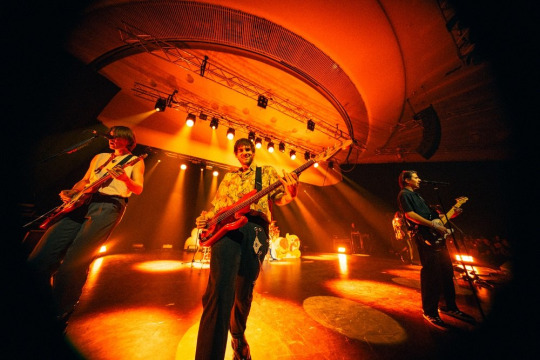
PHOTO: Vita Orehek
Joker Out played two unreleased songs in Helsinki – and it caused complete uproar!
The band Joker Out began their big European 'See You Soon' tour with two sold out concerts in Helsinki.
The Finnish audience, besides having the honour of opening the band's new tour, recieved a special gift they weren't expecting – the first performance of two completely new songs that caused an unseen hysteria in the fans! The effect was even stronger because both of the songs are in Serbian and most of the audience didn't understand a single word.
"We performed two unreleased songs for the first time in Helsinki – 'Šta bih ja' ('What would I') and 'Bluza' ('Blouse'). It's not necessary to point out that Finns don't understand the Serbian language, but the reaction was as though we were playing our absolute most popular songs. We were just looking at each other and smiling. When we returned to our hotel we saw that the reaction online was the same as the one we had experienced at the concert. A group of our fans at JokerOutSubs even activated and translated both of the songs into English using video recordings. Commenters on social media are asking us to release the songs, but they will have to wait a little because we are going to record them after the tour." – stated the band enthusiastically.
In mid-February Joker Out released their new single 'Everybody's Waiting', the sucessor of their amazing 'Sunny Side Of London'. They are going to, together with 'Šta bih ja' and 'Bluza' (which is currently a working title), be featured on the band's next studio album.
Joker Out sold all the tickets for the House of Culture in Helsinki, which means there were more than 3000 fans there. Ahead of them is a long tour that continues tommorow in Tallinn, and then in Riga, Vilnius, Krakow, Berlin, Leipzig, Malmö and many more cities. This tour, called 'See You Soon', encompasses 13 countries, including France, Belgium and Italy for the first time, with 22 concerts in some legendary, world-famous concert venues, for example, the O2 Shepherds Bush Empire.
Some of their festival appearences have also been announced, which include Sea Star Festival (23rd-26th May, Umag, Croatia), EXIT (10th-14th July, Novi Sad, Serbia) and Sziget (7th-12th August, Budapest, Hungary), at which the local fans will have the chance to hear 'Everybody's Waiting', 'Šta bih ja' and 'Bluza' live for the first time!
❗ DO NOT REPOST, and if you quote, please link back to this article.
#joker out#jokeroutsubs#bojan cvjetićanin#kris guštin#jan peteh#nace jordan#jure maček#heyyy we got noticed by the senpais!! 😆😆😆
63 notes
·
View notes
Text
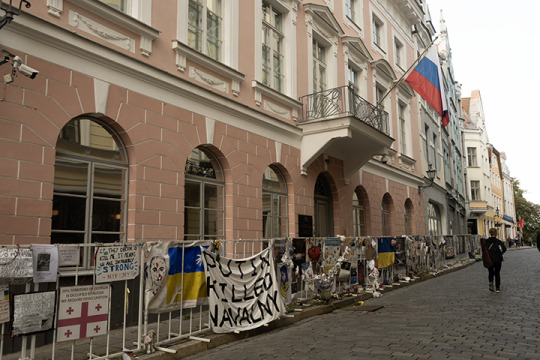
The 3 Baltic States — Lithuania, Latvia, and Estonia — are all very much aware that they are Putin’s next target if he wins in Ukraine. So they are understandably nervous about our election, as their future is at stake as much as ours.
We just wound up a 10-day trip to the Baltic capitals — Vilnius, Riga, and Tallinn — and are now in Helsinki, so I thought it a good time to report on what I saw and heard.
One local quoted to us Putin’s 2005 claim that the collapse of the Soviet empire “was the greatest geopolitical catastrophe of the century”. Not World War I, or World War II, or the Holocaust, and certainly not Stalin’s planned famines, but the breakup of the Russian/Soviet Empire. He means to restore it, including not just Ukraine but the Baltic States. And Byelorussia — but he already owns it in all but name. And Central Asia, and Poland, and anything else he can. He wants to make Russia as powerful, as respected, and as feared, as the old Soviet Union was.
The Baltic states are doing more than watching Russia in Ukraine; they are acting. All 3 states, but especially Lithuania (being the closest) have taken in many many Ukrainian refugees. Ukrainian flags fly on official buildings in all 3 capitals, and in many other places. I didn’t get a chance to visit the Russian embassy in Vilnius, but in Riga and Tallinn, there are protest signs and messages — some quite nasty — in front of and facing the embassies there. (See the photo on top for an example.)
These are not exactly actions calculated to make the Russian bear play nice. Putin already hates the Baltic states, Lithuania in particular, because their declarations of independence in 1991 are what helped trigger the final breakup of the old Soviet Union. (It’s more complicated, but that’s a decent short summary.) Yet the Lithuanians, the Latvians, the Estonians are speaking and acting in ways that will anger Putin even more. Their love of freedom, pride in their heritage, and sense of responsibility all demand it of them. In one city, we visited volunteers making camouflage netting for Ukrainian soldiers, and even helped (or tried to help) weave a few strands. More important than trying to help, though, was our showing up, hearing their stories, and encouraging them to persevere. They are spending as much as 5% of their GDP on their defense (the exact numbers are not clear). They are preparing for war. One expert told us that it is an open secret that their plan is to hold out for 72 hours, long enough for the West to respond.
Which we will be obliged to do. All 3 nations have been members of NATO since 2004, and entitled to Article 5 protection which proclaims that an attack on one NATO member is an attack on all, and that all will respond to such an attack with all means necessary, including armed force.
This is why I called the Baltic States the canary in the coal mine in my title. They are members of NATO, while Ukraine is not. If Putin attacks any of them, the United States is obligated to come to their defense. Putin is very well aware of this, and so will only attack if he has calculated that we will not respond as we ought. When we read reports about Russian interference in our elections, we must understand what Putin is trying to accomplish: the destruction of NATO so that it will not be able to respond when he invades a NATO ally like Lithuania, or Latvia, or Estonia.
We are with a group of Americans and not supposed to discuss US politics, but I managed several private talks with locals, including a diplomatic contact. All of them are very aware of our upcoming election and very concerned about what it will mean for them if Trump manages somehow to regain power. They know very well what he’s had to say about our NATO responsibilities.
The US has generally been fortunate in its wars (the Civil War being a major exception). We have not had to fight on our home ground; when we go to war, we fight on other people’s land. That allows an illusion of safety which we can no longer afford. It’s not just the missile threat; it’s cyber threats and terrorism. A Latvian reporter for the New York Times wrote the other day about how Putin is able to reach out anywhere in the world to attack individuals who oppose him (or who even decline to support him by joining the army): Putin Is Doing Something Almost Nobody Is Noticing
There are also the hundreds of thousands of Russians who left home because they did not want to have anything to do with Vladimir Putin’s war or were forced out, accused of not embracing it enough. These low-profile dissenters are subjected to surveillance and kidnappings, too. Yet their repression happens in silence, away from the spotlight and often with the tacit consent or inadequate prevention of the countries to which they have fled. It’s a terrifying thing: The Kremlin is hunting down ordinary people across the world, and nobody seems to care.
One cannot travel to the Baltic States without becoming aware of just how fragile our freedoms really are. ALL our freedoms — for if the Baltic States fall, so too will the rest of Europe, and so too will we. It is critical to defeat Trump and elect Harris for many reasons, including reproductive rights, freedom of religion, freedom of speech, freedom to dissent, freedom to think. In addition to that, it is critical to stop Trump in order to stop Putin (with the recognition that Putin will still keep trying even if he fails to put Trump in power). In the United States, this can seem a bit abstract. Here in the Baltic States, it is much more immediate and real.
33 notes
·
View notes
Text
Salaspils: A Soviet Memorial To Nazi Victims In Latvia
Eighteen kilometres out of Riga, a series of stone giants stand frozen in a forest clearing to mark a place that some would rather forget.

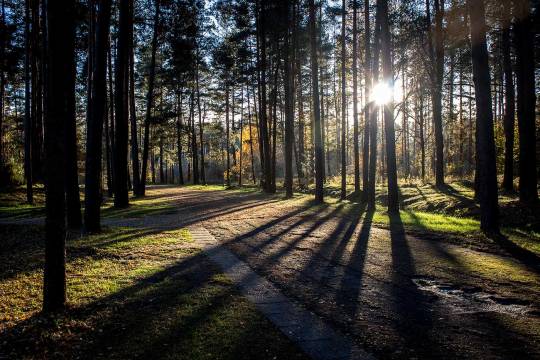
The forested approach to the Salaspils Memorial.
The road to the Salaspils Memorial Ensemble stops near the rail tracks, and visitors must walk the final stretch – through forests of pine, and birch that in autumn explodes into canopies of red and gold, the sunlight slicing sideways between trunks that shed their crisp white bark like snakeskin.
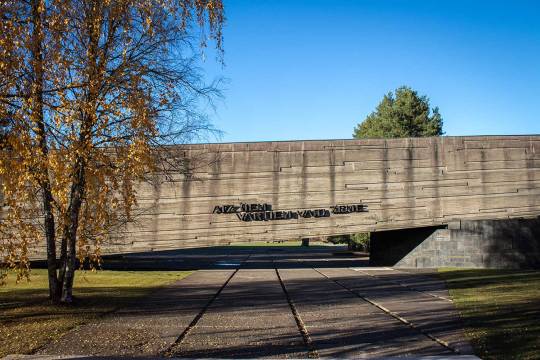
The gallery building measuring 100 metres long by 12.5 metres high.
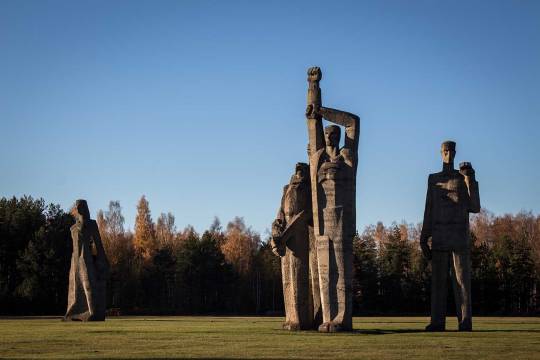
In the clearing beyond stands the Salaspils Memorial Ensemble.
The forest feels alive, almost supernaturally so, making it all the more abrupt to find the path suddenly barred by a looming concrete crossbeam, 100 metres long and more than 12 metres tall. This concrete barrier is a visitor building, an abstract Brutalist gallery that marks the symbolic threshold between life and death. It stands in the place where once there was a guardhouse ringed in barbed wire, the entrance to a former Nazi labour camp that operated for four years here amidst the picturesque Baltic birch. Through the arch, a clearing opens up between the trees; the camp barracks long gone, to be replaced by angular Soviet forms, towering, blocky figures stood as tall as the trees that surround them.
Above the entrance, a Latvian slogan is spelled out on the concrete flank of the gallery “Beyond these gates the land groans”, a line from a poem, written by a former prisoner of this place.

Part of the original wall of Camp Kurtenhof.
SS-Sturmbannführer Rudolf Lange, who was appointed in 1941 a commander of both the Nazi Security Service and the Security Police for occupied Latvia, that same year proposed the creation of a detention facility in the region. It was named Camp Kurtenhof, from the German name for the town of Salaspils, and located for convenience just off the main rail track between Latvia’s two largest cities: Riga and Daugavpils. It was designated a Police Prison and Labour Correctional Camp.

A symbolic tally etched into the gallery building counts time inside the prison.
Work on the camp began in late 1941, and it was built largely by the hands of Jewish prisoners deported from occupied Germany, Austria and Czechoslovakia. At least a thousand Jews were transported from the Riga Ghetto to join the construction team in January 1942. Offered little in the way of comfort, nutrition or sanitary facilities, they were overworked and many would die to that first harsh Baltic winter.
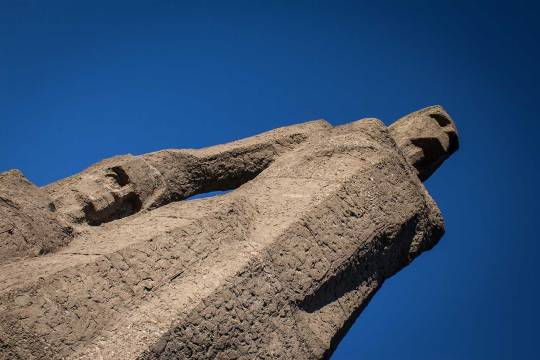
Symbols of Soviet defiance raised on the grounds of the former camp.
These workers were amongst the only Jews to ever set foot in the Salaspils camp. Unlike the Reich’s concentration camps, which answered to their own central administration in Berlin, the Police Prison Camp at Salaspils was under the direct control of local Security Police Commander Rudolf Lange. Its inmates were political prisoners and Baltic dissidents, expanding in summer 1942 to provide ‘labour correction’ to those caught avoiding work regulations; and from 1943 the camp began taking in Baltic police officers and military personnel convicted in SS courts. The Salaspils camp also operated as an intermediary transit camp for prisoners being transported from Belarus and Russia, to forced labour projects in Germany. A large number of children were imprisoned at the camp too, allegedly in dedicated children’s barracks.
youtube
By the later part of 1942 the camp consisted of 15 barracks that between them housed 1,800 prisoners. By summer 1943, there were 30 barracks. Prisoners here were involved in the digging and processing of peat, and according to survivors’ accounts, regardless of its specific ‘Police Prison’ designation, the organisation of work, and treatment of prisoners at Salaspils, was just as brutal as any of the other Nazi camps in the region.

From left to right: Solidarity, The Oath and Red Front.
The official website for the Salaspils Memorial states that, during its years of operation, roughly 23,000 people were imprisoned at the camp. It reports that from May 1942 until September 1944, up to 500 prisoners died of diseases, as many as 150 from exhaustion or brutal punishment regimes, and a further 30 were shot while attempting to escape. The younger prisoners were particularly susceptible to the diseases (such as measles and typhoid fever) that ran rife through the inmate population. It is believed that half the camp’s children died from illness, and after liberation, a mass grave was discovered containing the corpses of 632 children aged 5-9 years old. The Salaspils website suggests that, including the Jewish forced labourers who died during construction, the final death toll of the Salaspils camp stood at more than 3,000 people.
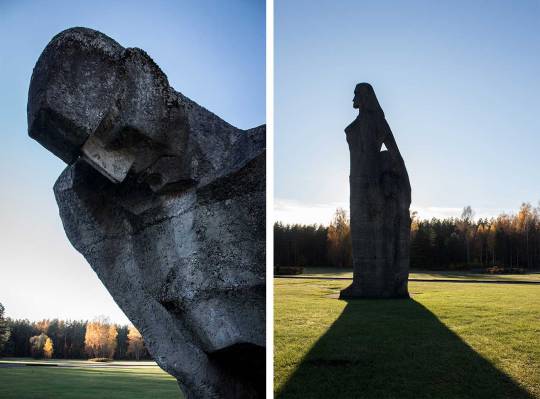
Left: The Unbroken; right: The Mother.
The Salaspils camp was liberated by the Soviets in September 1944. The fences were brought down, the barracks destroyed, but it wasn’t until two decades later that they constructed a grand memorial complex on the site where the camp once stood. A competition was held to select a design for the Salaspils Memorial Ensemble, as it was known, with the winning entry submitted by a team of seven: the architects Gunārs Asaris (who would also create the Monument to the Sailors and Fishermen Lost at Sea, at Liepāja), Oļģerts Ostenbergs, Ivars Strautmanis and Oļegs Zakamennijs, along with the sculptors Levs Bukovskis, Oļegs Skarainis and Jānis Zariņš. The park opened in 1967, and in 1970 its creators would receive the prestigious Lenin Award for their work – in the same ceremony that saw architect Yevgeny Vuchetich awarded for his famous monument at Volgograd: The Motherland Calls.
The opening ceremony was a grand, flower-laden affair, and the Salaspils Memorial Ensemble would go on to be considered one of the most important Soviet memorial sites in the Baltics.

The sculpture called Humiliated.
Today it is not a particularly easy place to visit, and emerging from the trees into the clearing is a sobering moment. The simplicity of these concrete forms invites imagination. Instead of telling you what happened here, this place tries to make you feel it. I found myself reminded of my visit to Auschwitz – a visit I made on a warm summer’s day, birds singing, woodland flowers in bloom. If anything the setting for Salaspils was even more picturesque than that, and I felt a sense of emotional whiplash, after a while, constantly trying to square what I knew about this place with the information my senses were providing me.
The ensemble is built around nine concrete titans (in six installations), who tower over the neat lawns and were said to represent the different types of prisoner kept in the camp. ‘The Unbroken’ lies on his belly, pushing himself up with his last strength. ‘The Mother’ has a look of defiance, standing square to shield the infants that cower by her side. ‘The Humiliated’ kneels, her face partially hidden by an arm raised in a defensive gesture. In the very centre of the lawn, three forms are arranged side-by-side: ‘Solidarity’ shows one prisoner helping another to stand; ‘The Oath’ is a man stood tall stretching his arms into the air; while ‘Red Front’ likely represents a fighter from the paramilitary wing of the German Communist Party – the ‘Rotfrontkämpferbund’ – a group who used the same single-handed fist salute depicted here.
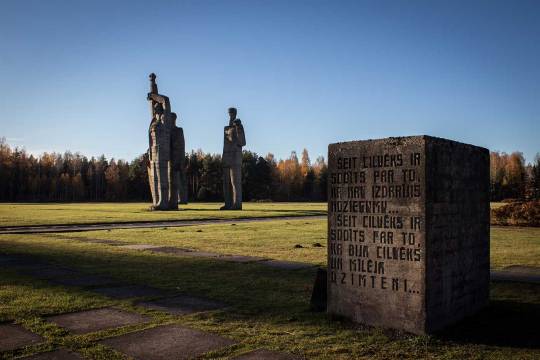
A memorial block where the camp’s gallows once stood.
The Salaspils Memorial features hardly a written word of information but that does not make it a quick place to visit. The monuments that decorate the lawn demand consideration. A single notable script appears on a stone block placed off to the right, between the central figures and the entry gate, marking the location of the former camp gallows. Its inscription in Russian and Latvian reads: “Here humans were executed for being innocent… Here humans were executed for every one of them being a human and loving the Motherland.”

Fragments of the original barrack walls.
At the opposite side of the Road of Death – as the designers named the walking path that circles their concrete giants – a black granite pedestal is designated as the place for laying flowers and memorial wreaths. From somewhere out of sight comes the ticking of a metronome. Intended to suggest life, and the eternal passage of time, the sound is rather like a heartbeat, and lends an uncanny atmosphere to my time amongst the statues.
The old camp buildings may be gone, but here and there, fragments of the outermost walls remain. Some are bare, but others are piled with tributes: plastic angels, Orthodox icons, a selection of sad-looking children’s toys. It feels like an effective memorialisation technique – bulldozing the camp, symbolically destroying its physical legacy, while leaving just enough of its form behind to suggest a historical record of its size and inner geography. Just a year before the Salaspils Memorial opened, the Yugoslav architect Bogdan Bogdanović had accomplished something similar at his Jasenovac Memorial Site, in what is now Croatia: the buildings of the old concentration camp were destroyed, but there, the ground was landscaped into mounds and craters that recorded the location and function of the various different buildings.

Text across the wall of the gallery “Beyond these gates the land groans.”
The only building at Salaspils now is the gallery – entered by an inclined walkway that passes through the length of the imposing concrete arch above the entrance. The space inside is oppressive and claustrophobic, presumably by design. This effect of sensory deprivation allows the visitor time to meditate, perhaps, and process the meaning of the monumental forms outside. When natural light does break through the side walls, it spills in at viewing slots reminiscent of wartime pillboxes. I peer outside, for a panoramic view of the figures on the lawn.
All the while, the sounds of the forest seem amplified as they reverberate though this enclosed space. There is birdsong, the noise of distant dogs barking, and somewhere nearby, where the original tracks cut lines through the trees, the shunting and hissing of cargo trains.

The walkway through the Brutalist gallery building.

The Salaspils Memorial Ensemble, seen from the gallery.
There is something inherently totalitarian about the form of remembrance prescribed by the Salaspils park. The sheer concrete, the lack of information. These twisted human figures tell visitors how they should feel, but the park never provided the tools for a two-way conversation. At Auschwitz visitors are shown piles of shoes, and suitcases, visual triggers designed to encourage an engagement with the numbers. At the National Museum of the Holodomor-Genocide in Kyiv, Ukraine, a similar effect was achieved with grains of corn – arranged in a heaped display where one grain stands for one Ukrainian life lost. Salaspils, in contrast, simply says: these people were punished for loving the Motherland.
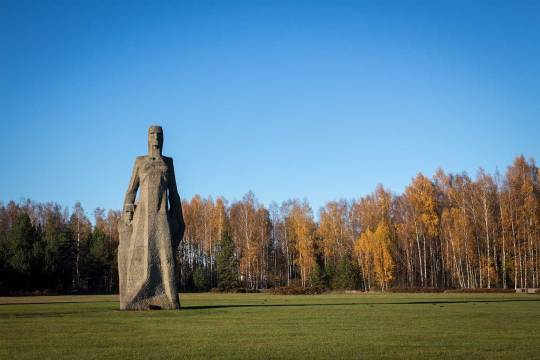
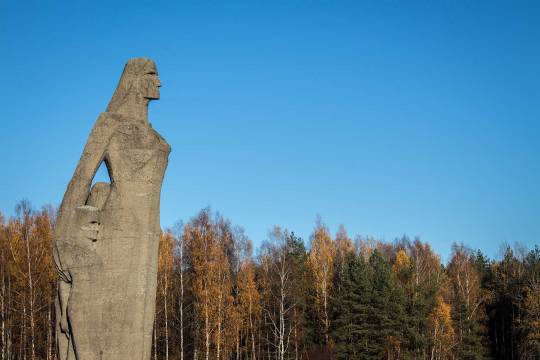
Commenting on the Soviet Union’s choice to memorialise Salaspils, Peter Hohenhaus notes how “other, even worse sites of the Holocaust such as Biķernieki received no commemoration at all.” It is perhaps no coincidence though, that the Soviets chose to create such a prestigious memorial over the remains of a camp which had less relation than most to the Jewish Holocaust. (Aside from the construction team, it is reported there were only 12 Jewish prisoners at Salaspils).
Following the war, the Soviet Union severely downplayed the significance of the Holocaust, to present the Soviet citizen, instead, as the chief target of Nazi aggression. Any specific commemoration of the Jewish tragedy was at least discouraged. For example there was a Holocaust memorial built in Minsk, Belarus, named ‘the Pit’; an obelisk on the site where 5,000 prisoners from the nearby Minsk Ghetto were executed by fascists in 1942. Its creators, the stonemason Morduch Sprishen and the poet Haim Maltinsky (who wrote the Yiddish inscription), were both later convicted on charges of Jewish nationalism, and after that, the authorities treated all visitors to the Pit memorial with suspicion. At Babyn Yar meanwhile, a ravine in Kyiv were tens of thousands of Jews were massacred, the victims of the Holocaust are still yet to be recognised with a proper memorial.
The USSR’s post-WWII efforts to ideologically bond its member republics through a shared sense of victimhood, and victory, was felt not least strongly in places like the Baltics – countries who were new Soviet subjects, and uneasy subjects at best. What better place then, for a grand Soviet memorial park, than Salaspils: a police camp that had chiefly housed antifascist Baltic dissidents, and Soviet citizens from Russia and Belarus. It was a place where Latvians and Russians had suffered together, side by side, and of all the dark places left to this region in the wake of Nazi occupation, this was the one whose memorialisation best supported the post-war political narratives of the Soviet Union.
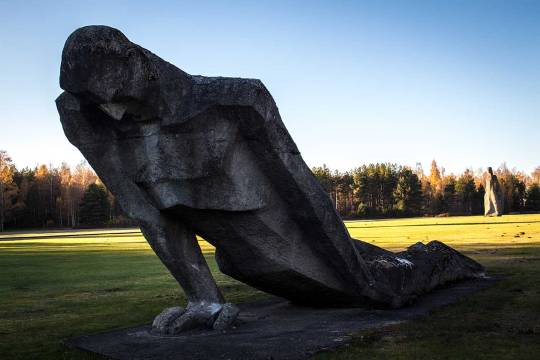
The Salaspils Memorial is recognised as part of the Latvian Culture Canon and in 2017, it was declared a monument of national significance. Despite this recognition however, it doesn’t feel like a place that is cherished, so much as observed. Visitors often report having trouble locating the place, and it hardly seems to be promoted as a tourist destination of note. When compared to videos showing the park’s opening ceremony (crowds of people, neatly trimmed lawns, and the forest pruned back around them), Salaspils today appears somewhat lonely and dishevelled.
Contemporary additions and modifications to the park have seemingly challenged the innate Sovietness of the place. A cemetery for German POWs was added in 2008, adjacent to the main memorial grounds. More recent is the installation of the Salaspils Memorial Exposition. Housed inside the Brutalist gallery building, the collection has been open to visitors since February 2018, and features information and video clips available in Latvian, German, English and Russian.
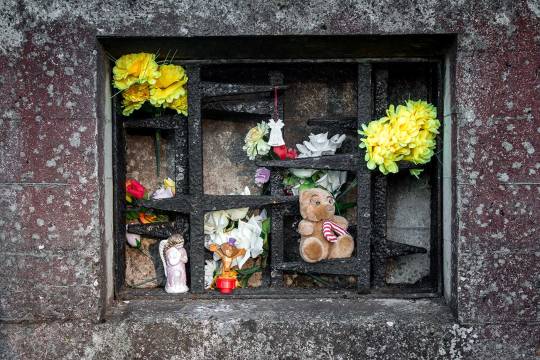

Tributes left by visitors to the Salaspils Memorial.
Elsewhere around the park, and dotted along the ‘Road of Death,’ new information panels have been installed to give context to the park’s otherwise sparse concrete symbolism. The memorial architecture of the park tells the story of Soviet people who fell victim to the Nazis. It is somewhat jarring then, to read contemporary panels that describe both Nazi Germany and the Soviet Union as “occupying regimes.” This is, of course, how the Latvians officially remember that portion of their history: as a violent occupation by a foreign power that would maintain a political and cultural stranglehold over Latvia for the next 45 years. If it seems strange to foreign visitors that a site as significant as this – and so close to the capital – should feel quiet, hidden away, and poorly advertised, then perhaps this is why: from a Latvian perspective, the Salaspils Memorial might very well feel like a monument built by one trespasser to present themselves as the chief victim of the previous one.
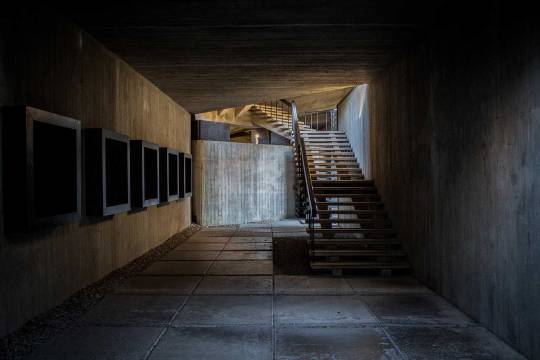
The main gallery space inside the visitors’ building. Below: the staircase inside the inclined viewing gallery.
According to the website, the new exhibition “provides visitors with information based on historical facts and the conclusions of the latest scientific studies,” in an effort to “dispel misconceptions about the Camp and the Memorial.”
Those “misconceptions” presumably include certain claims made in the Russian-language media. Many on that side of the border still believe the former Soviet account, which once stated that over 100,000 people had died at Salaspils (compared to the 3,000 cited today by the Latvians). There were stories, too, that the Nazis drained blood from children here to use in transfusions for German soldiers – though these seem to have since been largely debunked. Nevertheless, news outlets like RuBaltic.ru and Ukraina.ru accuse the park’s Latvian management of downplaying the numbers, rewriting history, and more generally of presenting the Nazi presence in Latvia as having been less harmful than that of the Soviets who liberated this camp. They refer to a new information panel at the Salaspils Memorial, which shows respective death tolls for the periods of Nazi and Soviet occupation; the Soviet number being the larger of the two.
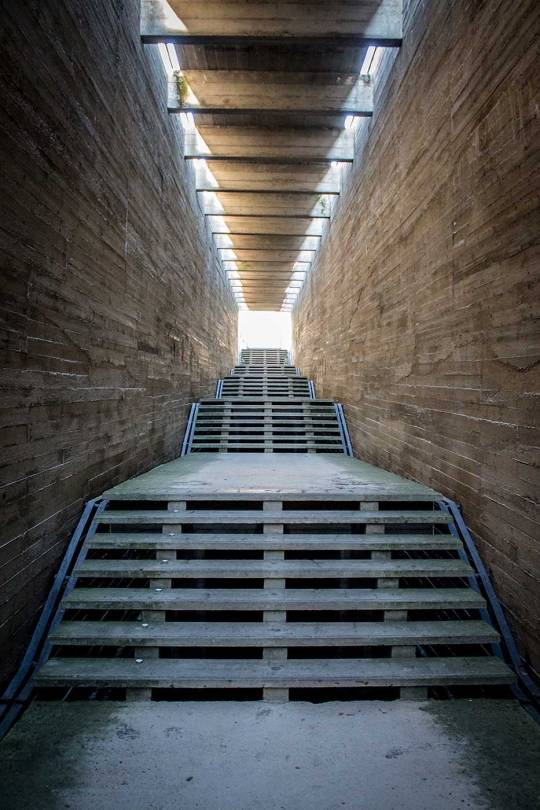
While obviously Latvia can and should be having these conversations, I can’t help but wonder if it isn’t slightly antagonistic (at least, to the ethnic Russians who make up a quarter of Latvia’s population), to have them here; to stand on the symbolic graves of dead Soviets while comparing them to the Nazis.
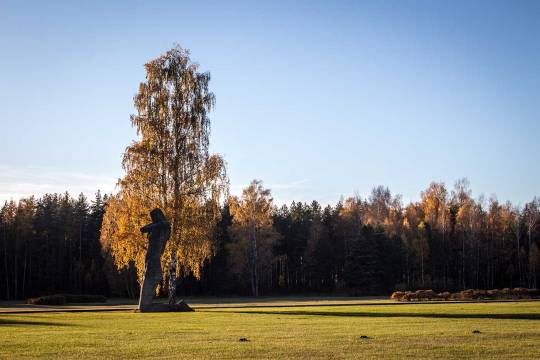
‘The Humiliated’ is partially hidden now, behind a tree not part of the original design for the memorial.
Memorials should serve a simple task, in theory: they remind us of things that we must not forget. They preserve important stories for those who were not there, and in societal terms, they serve to reclaim – to re-consecrate – ground once bloodied by violence. Danger zones become places of (re)education. But the invisible memory wars that continue to be waged across this quiet lawn in Latvia are anything but simple, and they hint at some of the greater cultural conflicts at large today in the post-Soviet Baltic states.
The last thing I saw before I left was another new, post-Soviet addition to the park. In 2004, a former prisoner at Salaspils named Larry Pik funded the creation of a new monument to the Jewish victims of the camp – the prisoners who built it. Accompanied by the Star of David, an inscription in Hebrew, German and Latvian reads: “To honour the dead and as a warning to the living. In memory of the Jews deported from Germany, Austria and Czechoslovakia, who from December 1941 to June 1942 died from hunger, cold and inhumanity and have found eternal rest in the Salaspils forest.”
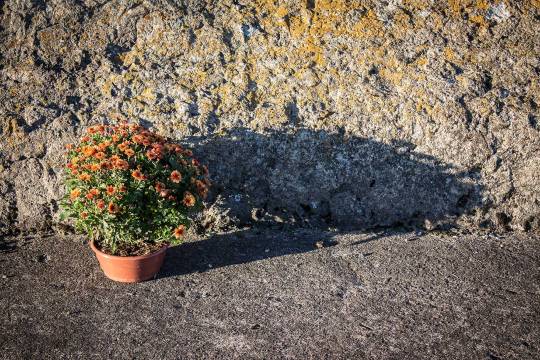
Flowers left in memory of the camp’s victims.

The cover of a 1969 commemorative book about Salaspils.
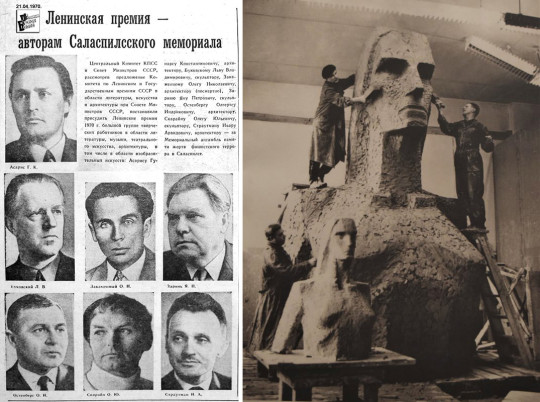
Left: a newspaper announces the Lenin Award given to the Salaspils design team. Right: ‘The Mother’ under construction.

‘The Unbroken,’ under construction, and then completed.
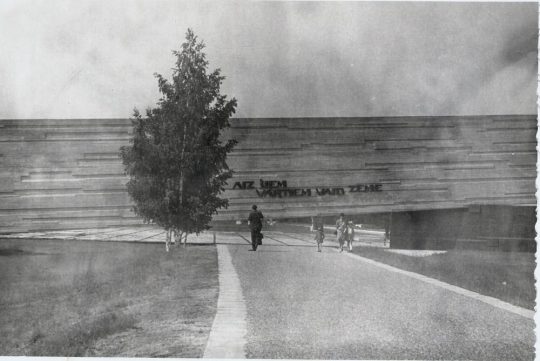
The gate to the Salaspils Memorial (late 1960s).
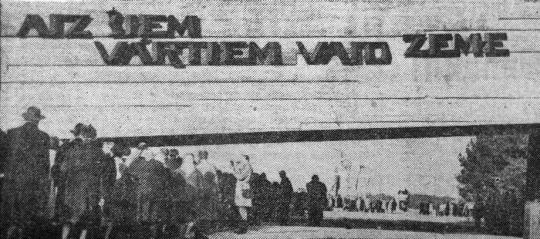
Visitors queue to enter (late 1960s).
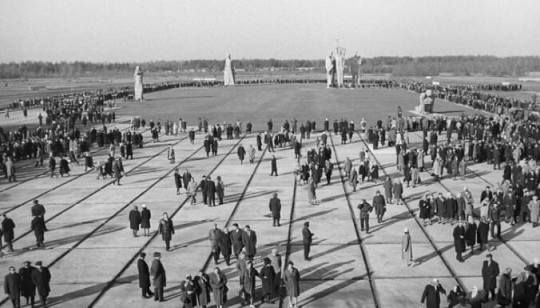
The memorial plaza at Salaspils (1968).

Left: Salaspils in 1975. Right: Cover of the 1985 Salaspils brochure.
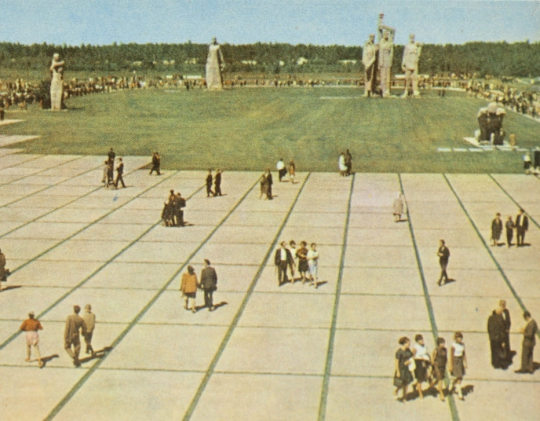
The Salaspils Memorial Ensemble in 1970.
–
by Darmon Richter
[adapted with permission from an article at Ex Utopia]
248 notes
·
View notes
Text
The Riga wreck
In October 2021, archaeologists announced that they had found an oak wreck fragment about 4m long and 1.3m wide on the beach at Daugavgriva, near the Lighthouse, near Riga, Latvia.

The fragment is only a piece of the hull with planks about 25cm wide and 8cm thick, attached to the ribs with wood and copper pins. What this piece belonged to can only be guessed at today, as both a warship and a merchant vessel are possible.

It may have been a British vessel that landed there in the early 19th century. The coastal area with the lighthouse was only developed around the middle of the 19th century and it is therefore possible that the wreck was then dismantled by local people.

So far there is only conjecture, as important investigations are still pending, but when these are completed, more can possibly be said about the origin and the age.
129 notes
·
View notes
Text
I am really excited about Joker Out coming to Riga because most artists skip Latvia, but i’m not sure if they can sold out the venue they are playing. Latvians aren’t the most active concert goers and Eurovision isn’t too big here anymore. And i’m worried there won’t be too many people and then they’ll feel like they aren’t appreciated here.
So if anyone from abroad wants to go to JO gig and you don’t know where, Riga it is. And if you need a tour guide and a local friend, don’t be shy and hit me up!
P.S. Loreen is having a gig this week at the same venue and it’s nowhere close sold out.
#joker out#i was at the venue for Palaye Royale and it wasn’t full at all and PR is quite a big band#or my friend went to Billy Talent and it was the same story#idk whats wrong with latvians
22 notes
·
View notes
Text


Our local eastern European grocery store is a goldmine of tinned fish. These are delightful. It's so pretty! The fish are all packed so nicely in the jar! The flavor is mild and predominantly smoky; the fish are tiny but they have a lovely texture. Definitely buying these again. They're great on crackers as-is, but we made dip tonight.
1 8oz block of cream cheese
1 8oz jar of smoked riga sprats, or equivalent of your sardine/tinned fish of choice
1/4c chopped red onion
several fronds of fresh dill, chopped, if you've got it; 2-3tsp dried if you don't
1/2-1 tsp hot paprika or cayenne pepper, depending on your spice preferences
juice of 1 lemon
salt to taste
Blitz everything together in the food processor; garnish with capers or more red onion and a dash of hot sauce, smash with a box of triscuits while fending off the cats.
#tinned fish#appetizer#I do eat things other than sardines I swear#'tis the season for them though#made by me#5 ingredients is about my limit for recipe complexity right now I'm afraid
3 notes
·
View notes
Text

On September 3, 1917, we had another "liberation day" of Riga. Riga was "liberated" by the Reichswehr, but a year later, in honor of this event, we received the "Wooden Fritz" monument, Latvia. Source: Kaspars Zellis
P.S. You can try to count how many times Riga was liberated in the 20th century by different invaders? We Latvians actually don't like foreign invaders! "Foreigners" always come with some bad shit here.... war, invasion, repressions and bad religions...multiculturalism attacks on Latvian language, culture, prosperity (well the Russian communist occupiers called it "socialist internationalism", an anti-indigenous hate ideology aimed at forcing the natives out of their homelands...and replacing local population with Russian migrants...) ..
Basically modern pseudo-liberal "multiculturalism" is an anti-indigenous hate ideology aimed at forcing the natives out of their home land...

#Latvia#Riga#foreigners#invasion#German#german invasion#russian invasion#muslim invasion#european history#vintage photography#socialist internationalism
4 notes
·
View notes
Text


Israeli preparations for the "final solution" of the Palestinian issue. History repeats itself⬇️
In the autumn of 1941, approximately 338,000 Jews remained in Greater Germany. Until this point, Hitler had been reluctant to deport Jews in the German Reich until the war was over because of a fear of resistance and retaliation from the German population. But, in the autumn of 1941, key Nazi figures contributed to mounting pressure on Hitler to deport the German Jews. This pressure culminated in Hitler ordering the deportation of all Jews still in the Greater German Reich and Protectorate between 15-17 September 1941.
Following the order, Himmler, Heydrich and Eichmann attempted to find space for the Jews from the Greater German Reich in the already severely overcrowded ghettos in eastern Europe. Officials in the Łódź, Litzmannstadt, Minsk and Riga ghettos were all informed that they would need to absorb the population of Jews from the Greater German Reich, irrespective of overcrowding.
The Minsk Ghetto was full, so in order to make room for the Reich Jews, the local SD , German Army and local collaborators gathered approximately 25,000 of the local ghetto inhabitants, drove them to a local ravine, and murdered them. German Jews soon filled their places in the ghetto. Similar murders took place in Riga.
In Łódź Ghetto, no local Jews were removed prior to the arrival of 20,000 Jews from the Greater German Reich. Instead, following the success of the experiments in using gas vans for mass murder at Chełmno extermination camp in December 1941, deportations from the ghetto to Chełmno began on 16 January 1942, four days before the Wannsee Conference.
As with most of the Nazis’ murderous actions, the deportation of German Jews was improvised and haphazard . The increased numbers of Jews arriving in the ghettos of eastern Europe led to severe overcrowding, unsustainable food shortages and poor sanitation. This, in combination with the slow progress in the German invasion of the Soviet Union, convinced the Nazis that a ‘solution’ to the ‘Jewish problem’ needed to be organised sooner than had been originally envisaged. The deportations also partly led to the gas experiments at Chełmno, and heightened the Nazis’ sense of urgency to coordinate the policy towards Jews at the Wannsee Conference.
14 notes
·
View notes
Text
Finally some good news for once
6 notes
·
View notes
Text
CHI È VERAMENTE FLAVIO BRIATORE?
L’Espresso se lo chiese in questo articolo del 2010 a firma Mauro Munafò. Briatore ha sempre negato tale ricostruzione, mentre gli autori del libro “Il signor Billionaire" hanno sempre confermato. Ognuno legga bene l’articolo, non poco inquietante, e faccia (civilmente) le sue valutazioni.
“Le vittorie in Formula 1, il matrimonio con la Gregoraci e i flirt con le top model, lo yatch da sogno e il Billionaire, la discoteca dei ricchi in Sardegna. Quando si parla di Flavio Briatore, sono queste le parole d'ordine della cronaca nazionale, gossippara e non. Eppure nel passato del manager di Cuneo ci sono zone d'ombra che stonano con la vita super-pubblica che conduce adesso.
Sono gli anni '70 e '80, passati tra Cuneo e Milano, in cui un giovane assicuratore inizia a costruire quello che poi sarà Mr Billionaire. E nella sua cerchia non mancano i personaggi discutibili, il gioco d'azzardo, le truffe, la latitanza all'estero e le morti sospette. Una scalata al successo partita dal basso e dalla provincia che non si legge però nella biografia ufficiale di Briatore, che a quegli anni dedica qualche riga generica e poco convincente.
A scavare nella vita del manager ci hanno pensato Andrea Sceresini, Maria Elena Scandaliato e Nicola Palma, tre giovani giornalisti autori di "Il signor Billionaire; ascesa, segreti, misteri e coincidenze", appena pubblicato da Aliberti Editore. I tre sono partiti da una serie di articoli di Gianni Barbacetto del '99 per approfondire i misteri del passato di Briatore. Un lavoro fatto alla vecchia maniera, cercando tutti i vecchi soci, i vecchi amici, le fidanzate e i conoscenti del rampante Flavio. E trovandosi spesso davanti un muro di omertà e di consigli a lasciar perdere questa storia, di non chiedere oltre perché ci sono verità "che fanno morti e feriti".
La storia di Briatore sembra il sogno americano, coniugato però alla realtà italiana. Figlio di maestri elementari, si diploma geometra, fa l'assicuratore e apre un ristorante (il Tribula) che chiuderà dopo poco per debiti. Ma la svolta arriva nei primi anni '70, quando lavora con Attilio Dutto, un costruttore locale che rileva la Paramatti Vernici. Nel frattempo Briatore si occupa per alcuni casinò (gestiti dalla malavita) di portare clienti ai tavoli, intascandosi una parte delle loro perdite. Al giro lo introduce Ilario Legnaro che con il boss catanese Gaetano Corallo (vicino al clan Santapaola) si occupa proprio di questo. Tra i clienti portati ai casinò da Briatore c'è proprio Dutto che perderà parecchie decine di milioni nelle sale di Nizza e della Costa Azzurra.
Nel 1979 Attilio Dutto salta in aria con la sua auto: un delitto che non ha mai trovato un responsabile. Dalle testimonianze raccolte nel libro si configura però la mano della mafia. Pare inoltre che lo stesso Dutto volesse "rovinare" Briatore per le truffe che gli aveva giocato. Di sicuro con Dutto scompare anche un capitale stimato in almeno 30 miliardi di lire, che non si sa dove vanno a finire.
Con la fine degli anni '70 e la morte di Dutto, Briatore si trasferisce nella nascente 'Milano da bere', dove conosce la sua prima moglie (fino a oggi tenuta quasi nascosta) e frequenta la gente che conta del capoluogo meneghino, non ultimo Bettino Craxi. Organizza feste e si mette in affari con il conte Achille Caproni, della cui moglie è nel frattempo amante. Con l'amico Emilio Fede, secondo gli autori del libro, organizzerebbe truffe ai tavoli verdi, finché la polizia non lo scopre e lui deve fuggire a St.Thomas, nelle isole Vergini, con moglie al seguito.
Latitante e costretto a rimanere fuori dall'Italia fino all'amnistia del 1990, Briatore si consola nella sua vita da sogno alle isole Vergini e apre e gestisce una rete di negozi per Benetton, un locale notturno e una gelateria. Da lì ci saranno la Formula 1, i mondiali con Schumacher e...mister Billionaire. Il "self made man" di Verzuolo in provincia di Cuneo ormai ce l'ha fatta: è diventato qualcuno, è famoso nel mondo, ricco e invidiato.
"E' il personaggio simbolo di un'intera classe dirigente", spiega Andrea Sceresini, uno degli autori. "La sua immagine pubblica non risente affatto del suo passato. Molte di queste storie sono state scritte anche dai giornali negli anni '70 e '80 e basta una ricerca in archivio per tirarle fuori. I media però si limitano a riportare quello che dice lui e la sua versione della storia".
Una versione che da copione prevede poche righe di biografia ufficiale e qualche risposta evasiva a chi gli chiede conto del passato. Una storia tutta italiana”.
(da "L'Espresso" dell''8 novembre 2010: https://bit.ly/2EE1y0t)
28 notes
·
View notes
Text
NATO member state Latvia is installing anti-tank concrete pyramids, known as "dragon's teeth," along its border with Russia as part of an effort to defend against the country as tensions rise over the war in Ukraine, a video circulating on social media appears to show.
"Latvia has started installing defensive barriers on its border with Russia. The so-called 'dragon's teeth' were spotted near the easternmost Latvian town of Zilupe," Anton Gerashchenko, a former adviser to Ukraine's minister of internal affairs, said on X (formerly Twitter), sharing the footage.
Dragon's teeth, first used during World War II, are made of reinforced concrete and are used to impede the advances of tanks and mechanized infantry.
Newsweek couldn't independently verify when or where the footage was filmed.
Tensions between Russia and NATO have remained high throughout Russian President Vladimir Putin's invasion of Ukraine. Moscow has accused the alliance of involvement in the war by providing Kyiv with military assistance and weapons.
Russian officials have regularly floated the possibility that Russia could strike NATO members in response to the aid they have provided Ukraine with.
In January, the Baltic States—Latvia, Lithuania and Estonia—signed an agreement in the Latvian capital, Riga, to create a common defense line with "anti-mobility infrastructure elements" to bolster NATO's eastern border with Russia and Putin's ally, Belarus.
Latvia's Ministry of Defense told Newsweek that counter-mobility obstacles are being "procured and transported to temporary storage areas near Latvia's eastern border" in accordance with the Eastern Border Fortification and Counter-Mobility Plan, which was approved by the Latvian government on March 5.
"The obstacles will be set on the border according to the mentioned plan," the ministry said.
"From a military perspective, this initiative will significantly boost our capability to protect our borders at the national level; we will be able to slow down and block the movement of potential aggressors more efficiently," Latvia's Defense Minister Andris Sprūds said in a statement in January.
Sprūds added: "This is a joint project for Baltic countries, which will also advance NATO's collective defense."
Local publication tv3.lv reported in March, citing the country's defense ministry, that the defense line would include support points for the National Armed Forces units along the border; defensive positions for soldiers and fortified defensive positions; various obstacles; anti-tank ditches; ammunition and mine depots.

In April, Poland's Foreign Minister Radosław Sikorski said in an interview with German newspaper Bild that he "wouldn't be surprised at all" if Russia attacks his country. "Russia has attacked Poland many times in the 500 years of our history," he added.
"But, in this scenario, Russia will lose, because we, the West, are far more powerful than Russia," Sikorski said.
Serbian President Aleksandar Vučić said on Monday that he believed NATO member states were rapidly preparing for a potential war with Russia.
"They are not ready now, but I think they will be ready. They are already preparing for a conflict with the Russian Federation and are preparing much faster than some people would like to see, in every sense," Vučić told the Serbian TV channel Pink, according to Russia's state-run news agency Tass.
"We know this from military preparations. We know how they are being conducted. And I want to tell you, they are preparing for a military conflict," Vučić said.
5 notes
·
View notes
Text
Ci sono questo ragazzo
e questa ragazza
mi sono seduti davanti
qualcosa di più di vent’anni
l’uno accanto all’altra
il treno ci porta da sud a nord
e lei ha capelli biondi, corti
e lui porta occhiali pesanti, scuri.
Leggono ma non leggono due libri diversi, leggono lo stesso libro.
Il fatto però è che non sono due copie dello stesso libro.
I due ragazzi, seduti l’una accanto all’altro leggono
da una sola copia
dello stesso libro.
È lei che lo tiene in mezzo
e gira le pagine lentamente
e sono davvero sincronizzati bene
questi due ragazzi seduti davanti a me
in questo treno regionale lento
concentrati, silenziosi e sincronizzati
e molto vicini.
Ed io li guardo
non riesco a non guardarli
sono affascinato da questo loro modo intimo di leggere
da questa lettura di coppia
che non mi sembra di aver mai visto
e faccio mente locale
e in effetti, nei locali della mia mente
non trovo nulla di simile
trovo sì due ragazzini che si dividono gli auricolari
trovo sì me stesso che guardo un film
accanto a una donna
sdraiati sul mio letto
come è difficile concentrarsi
senza toccarti
baciarti
farsi.
E a un certo punto lei fa per voltare pagina
e lui le sfiora la mano
è in ritardo di qualche riga
lei si ferma, sorride impercettibile
ma io quel sorriso lo percepisco.
Pochi istanti e
lui la sfiora di nuovo
ora può andare avanti
girare pagina.
E che bella cosa che stanno facendo
questi due innamorati
perché io li immagino innamorati
mi è impossibile pensare che non lo siano
lo sono.

Guido Catalano -"Ci sono questo ragazzo e questa ragazza."
2 notes
·
View notes